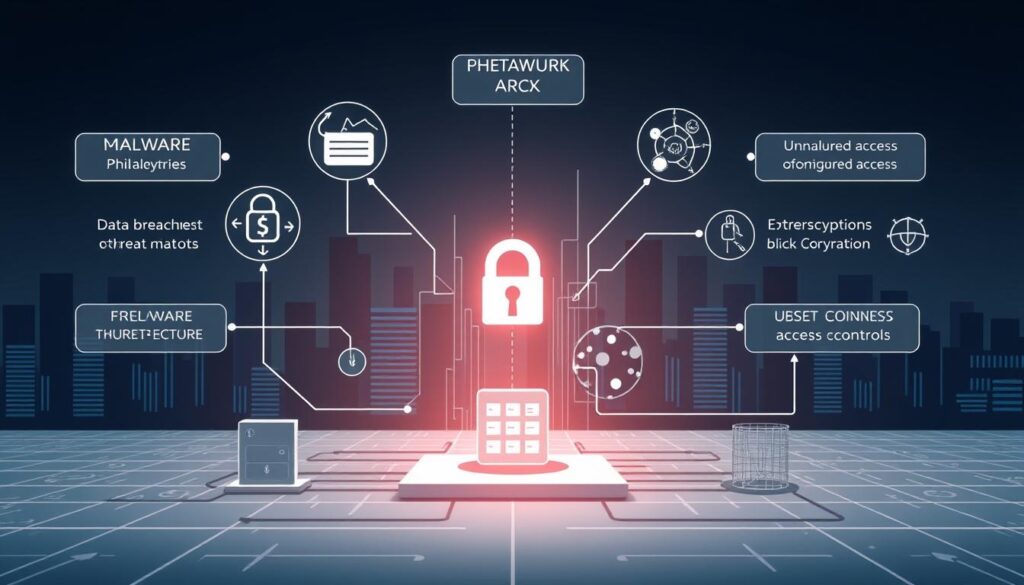Did you know that cybercriminals could steal your data in less than a minute? With digital threats evolving daily, protecting your online presence is no longer optional—it’s a necessity.
Every click, login, or transaction exposes you to potential risks. From phishing scams to ransomware attacks, hackers exploit vulnerabilities in networks and devices. The stakes are high: IBM predicts cybercrime costs will hit $10.5 trillion annually by 2025.
Effective security combines technology, processes, and user awareness. The NIST framework outlines five critical steps: identify risks, protect systems, detect breaches, respond quickly, and recover efficiently. Companies like Cisco automate threat detection, while Talos researchers analyze emerging risks.
Key Takeaways
- Cyberattacks can compromise personal and business data rapidly
- Modern security requires protection across devices and networks
- Cybercrime damages may exceed $10 trillion within two years
- The NIST framework provides actionable defense strategies
- Combining automated tools and human vigilance offers strongest protection
What Is Cybersecurity?
The rapid evolution of digital threats demands robust protective strategies. Organizations now prioritize frameworks that go beyond basic defenses to safeguard sensitive data and systems. This shift reflects the growing complexity of attacks targeting network security and user identities.
Defining Cybersecurity in the Digital Age
Traditional security relied on perimeter defenses like firewalls. Modern approaches, such as Zero Trust, require continuous verification of users and devices. Cisco’s Identity Intelligence platform exemplifies this by monitoring access in real time.
Core Objectives: Confidentiality, Integrity, Availability
The CIA triad forms the foundation of effective security solutions:
- Confidentiality: HIPAA compliance ensures patient records remain private.
- Integrity: Banks use blockchain to validate transaction accuracy.
- Availability: Cloud providers deploy redundancy to prevent downtime.
The NIST framework operationalizes these goals through five functions: identify, protect, detect, respond, and recover. With a projected 32% job growth in InfoSec by 2032, mastering these principles is critical for professionals.
Why Cybersecurity Matters More Than Ever
Financial losses from digital intrusions now surpass natural disaster damages in many industries. The 2025 IBM Security report reveals breach costs jumped 9.7% in two years, averaging $4.88 million per incident. Small businesses face disproportionate risk, with 41% reporting attacks last year.
The Rising Cost of Data Breaches
Healthcare organizations now spend $10.1 million per breach—triple the cross-industry average. Financial institutions follow closely at $5.9 million, as criminals target payment systems. Cryptojacking incidents surged 400% since 2021, hijacking computing power for illegal cryptocurrency mining.
The Colonial Pipeline ransomware attack demonstrates cascading consequences. After compromising a single password, attackers disrupted fuel supplies across the Eastern seaboard. The company paid $4.4 million in Bitcoin, highlighting the growing sophistication of cyberattacks.
Protecting Personal and Organizational Assets
Modern security challenges extend beyond corporate networks. IBM X-Force found 30% of breaches start with stolen credentials. Attackers exploit the dark web to trade login details and coordinate large-scale campaigns.
AI-powered phishing achieves 53% success rates by mimicking writing styles. This makes employee training as crucial as technical defenses. For organizations, combining endpoint protection with identity verification reduces risk by 72% according to Cisco benchmarks.
Individuals should prioritize multi-factor authentication and credit monitoring. As data breaches become inevitable, rapid detection and response separate survivable incidents from catastrophic ones.
Common Types of Cybersecurity Threats
Attackers constantly refine tactics to exploit weaknesses in digital systems. From deceptive emails to unsecured cloud storage, threats evolve faster than many users can defend against them. Understanding these risks is the first step toward protection.

Malware: Viruses, Trojans, and Spyware
Malware spreads through infected email attachments, USB drives, or malicious ads. Viruses replicate themselves, while spyware silently steals login credentials. Trojans disguise themselves as legitimate software to trick users.
IBM reports a 62 trillion-fold difference in password crack times. Weak passwords accelerate malware infections, letting attackers hijack devices within seconds.
Phishing and Social Engineering Attacks
Fraudsters use social engineering to manipulate victims into revealing sensitive data. Spear phishing targets specific individuals, while BEC (Business Email Compromise) scams impersonate executives.
75% of attacks rely on these tactics. AI-generated deepfake voices now mimic CEOs, increasing scam success rates.
Ransomware: Holding Data Hostage
Ransomware encrypts files until victims pay a fee. Only 8% of organizations fully recover data after paying. The Colonial Pipeline attack proved even critical infrastructure isn’t immune.
Cloud Security Vulnerabilities
Misconfigured cloud security settings cause 15% of breaches. AWS S3 bucket leaks expose sensitive data daily. IoT botnets exploit these vulnerabilities to launch DDoS attacks.
Regular audits and access controls reduce cloud risks significantly.
Key Components of a Strong Cybersecurity Strategy
Building a resilient digital defense requires more than just antivirus software—it demands a layered approach. Modern security tools must work together to block threats across networks, devices, and user identities. Below are the three pillars of an effective security strategy.
Network Security: Firewalls and Beyond
Traditional firewalls filter traffic based on ports and IP addresses. Next-Generation Firewalls (NGFWs) add deep packet inspection and intrusion prevention. Cisco’s Zero Trust Network Access (ZTNA) reduces breach risk by 68% by verifying every connection attempt.
Secure Access Service Edge (SASE) combines network security with cloud scalability. It routes traffic through encrypted tunnels, blocking malware before it reaches corporate systems.
Endpoint Security: Protecting Devices
Every connected device is a potential entry point for attackers. CrowdStrike’s Falcon platform detects 94% of fileless malware attacks by monitoring memory processes. Healthcare providers use strict BYOD policies to isolate personal devices from patient records.
Endpoint Detection and Response (EDR) tools track suspicious activity across laptops, phones, and IoT devices. Real-time alerts help IT teams neutralize threats before data is compromised.
Identity and Access Management (IAM)
Microsoft’s Conditional Access policies analyze login attempts for unusual locations or devices. Multi-factor authentication (MFA) blocks 99.9% of account hacks, per Microsoft research. Cisco Duo’s implementation adds biometric checks for high-risk transactions.
Effective access management limits user permissions to only necessary systems. Regular audits ensure former employees or compromised accounts can’t retain access.
A robust security strategy integrates these layers—stopping threats at the perimeter, endpoints, and user level. As attacks grow more complex, combining automated security tools with proactive monitoring becomes non-negotiable.
Best Practices for Enhancing Cybersecurity
Effective protection requires consistent habits, not just one-time fixes. Over 60% of breaches stem from unpatched systems, proving routine updates matter as much as advanced tools. Below are proven methods to fortify defenses across teams and technology.
Regular Software Updates and Patch Management
Delayed patches create exploitable vulnerabilities. The SolarWinds attack showed how outdated software enables supply chain breaches. Establish SLAs for critical updates:
- Emergency patches: Apply within 24 hours
- Routine updates: Deploy within 7 days
- Legacy systems: Isolate or upgrade
Implementing Multi-Factor Authentication (MFA)
Multi-factor authentication blocks 99.9% of automated attacks. Not all MFA methods are equal:
- SMS codes: Vulnerable to SIM swaps
- Authenticator apps: Generate time-based codes offline
- Hardware tokens: Most secure for high-risk users
Employee Training and Awareness Programs
IBM found trained teams respond 3x faster to incidents. KnowBe4’s simulations reveal 38% of users click phishing links without training. Key tactics:
- Quarterly phishing tests with real-world examples
- MITRE ATT&CK framework drills for IT staff
- NIST’s 12-character password policy updates
Adopting these best practices shrinks attack surfaces dramatically. Combine them with layered tools for maximum resilience.
Advanced Cybersecurity Solutions
Cutting-edge tools are reshaping how organizations combat digital threats. Traditional defenses often fail against sophisticated attacks, prompting a shift to smarter cybersecurity solutions. Below are three innovations redefining protection.
Zero Trust Security Models
Google’s BeyondCorp proves Zero Trust works at scale. It verifies every access request, regardless of location. This model reduces lateral movement by 80%, stopping attackers from spreading.
Zscaler Private Access enforces strict identity checks. Users gain entry only to approved apps, not the entire network. Such granular control minimizes breach impacts.
AI and Machine Learning in Threat Detection
IBM’s AI spots 92% of novel threats by analyzing behavior patterns. Darktrace uses self-learning algorithms to detect anomalies in real time. Unlike rules-based tools, it adapts to new attack methods.
SentinelOne combines threat detection with automated response. Its deep learning models outperform traditional ML, cutting false positives by 40%.
Extended Detection and Response (XDR)
Microsoft Azure Sentinel consolidates data from endpoints, clouds, and emails. This detection response platform slashes incident resolution time by 65%.
MITRE Engenuity ranks XDR tools by efficacy. Top performers correlate alerts across security tools, revealing hidden attack chains. For enterprises, this means faster, smarter defenses.
Cloud Security: Challenges and Solutions
Cloud platforms now host 94% of enterprise workloads, yet 93% suffer from preventable misconfigurations. IBM research shows these gaps cause most breaches, costing organizations $4.4 million on average. With 73% of companies using multiple providers, cloud security requires specialized security solutions.
Understanding the Shared Responsibility Model
Cloud providers and users split protection duties differently. AWS handles physical infrastructure security, while customers secure their data security configurations. Microsoft Azure’s matrix adds application-layer protections for SaaS products.
The Capital One breach revealed critical gaps. Attackers exploited a misconfigured AWS firewall to access 100 million records. CloudKnox now helps enterprises manage permissions, reducing excessive access by 80%.
Securing Multi-Cloud Environments
Orca Security found 82% of multi-cloud deployments have cross-provider vulnerabilities. Tools like Cloud Security Posture Management (CSPM) automatically detect risks across AWS, Azure, and Google Cloud.
CASB solutions monitor applications for shadow IT, while CNAPP platforms combine network and workload protection. ISO/IEC 27017 certification verifies providers meet strict cloud-specific data security standards.
Gartner notes CSPM adoption cuts configuration errors by 58%. For organizations scaling cloud use, these security solutions prevent the next Capital One-scale disaster.
Mobile and IoT Security Considerations
Smartphones and smart devices now handle sensitive tasks, from banking to medical monitoring. These mobile devices and IoT devices multiply threats, with 68% of medical implants vulnerable to attacks. Protecting them requires tailored security strategies.
The Hidden Dangers of BYOD Policies
Bring-your-own-device (BYOD) policies increase breach risk by 43%, per IBM. Employees often disable updates or use weak passwords. The Jeep Cherokee hack proved attackers can hijack vehicles through infected smartphones.
Mobile Device Management (MDM) cuts compromise rates by 71%. Tools like VMware Workspace ONE enforce encryption and remote wipes. For access control, Android’s work profiles outperform iOS in enterprise settings.
Locking Down Connected Devices
Verizon’s 2023 report found 82% of IoT breaches exploited default credentials. Armis’ platform detects unusual device behavior, like a smart thermostat transmitting data to Russia. Even Zigbee smart-home protocols have flaws allowing unauthorized access.
NIST IR 8259 outlines critical security steps for IoT devices:
– Change default passwords immediately
– Segment networks to isolate smart gadgets
– Monitor firmware updates for vulnerabilities
From hospital IV pumps to factory sensors, every connected device needs layered protection. Combine MDM for mobile devices with IoT-specific tools to block evolving threats.
Cybersecurity for Small Businesses
Small businesses face unique security challenges with limited resources but high stakes. A single data breach can cripple operations—60% fold within six months, per U.S. Congress data. Tailoring a security strategy to budget constraints is critical for survival.

Tailoring Security Measures to Budget Constraints
Huntress MDR delivers enterprise-grade protection for $139 per endpoint monthly. For smaller budgets, Datto RMM offers remote monitoring at $120/user, automating patch management to reduce risk.
Prioritize free resources like CISA’s Shields Up program. It provides actionable checklists for organizations with under 50 employees. PCI DSS Level 4 compliance is also achievable with low-cost tools like Bitdefender GravityZone.
Essential Tools for SMBs
Malwarebytes and Bitdefender offer SMB suites under $500/year. Key features:
- Malwarebytes: Blocks 99% of ransomware for 10 devices
- ConnectWise PSA: Centralizes ticketing and alerts ($35/user/month)
- NIST Small Business Act: Guides cost-effective controls like multi-factor authentication
Cyber insurance premiums rose 28% in 2025, but policies often mandate specific security tools. Balance coverage costs with preventive investments to mitigate risk.
The Future of Cybersecurity
By 2030, today’s encryption standards may become obsolete. IBM predicts 85% of breaches will leverage AI by 2026, while quantum computers could crack RSA-2048 encryption within this decade. These emerging threats demand next-generation security solutions that outpace attackers.
Emerging Threats and Trends
5G networks expand attack surfaces by 300%, creating new vulnerabilities in IoT ecosystems. The MITRE D3FEND framework maps 152 countermeasures against evolving cyberattacks, from supply chain compromises to AI-generated deepfakes.
NIST’s post-quantum cryptography finalists include lattice-based algorithms resistant to quantum decryption. Meanwhile, homomorphic encryption allows data processing without exposing sensitive information—adoption grew 210% since 2023 according to Gartner.
CISA’s JCDC 2.0 initiative coordinates detection across agencies, while cyber ranges now train responders using real-world attack simulations. Unlike traditional red team exercises, these platforms test defenses against AI-powered threats in controlled environments.
The Role of AI and Automation
DeepInstinct’s prevention AI blocks 99.5% of zero-day malware, outperforming human analysts by 40%. Automated detection systems now correlate threats across endpoints, networks, and clouds in milliseconds.
Microsoft’s Azure Sentinel uses machine learning to reduce false positives by 62%. These solutions learn from each attack, creating adaptive defenses. As AI becomes weaponized, automated security tools will be essential for maintaining protection.
Quantum-resistant algorithms and AI-driven security platforms represent the next frontier. Organizations must prepare now for threats that traditional tools can’t stop.
Conclusion
Proactive measures now separate resilient organizations from vulnerable ones. With cybercrime costs projected to hit $10.5 trillion by 2025, continuous adaptation is non-negotiable. CISA’s performance goals and free NIST tools provide actionable steps for stronger protection.
Prioritize data safety by adopting XDR platforms and multi-factor authentication. Zero Trust models, like those from Cisco, reduce breach risks by 68%. IBM’s free threat intelligence feeds offer real-time updates on emerging cybersecurity risks.
Start with NIST’s CSF assessment to identify gaps. Combine automated solutions with employee training for layered security. The stakes are too high to delay—act now to safeguard your digital future.

